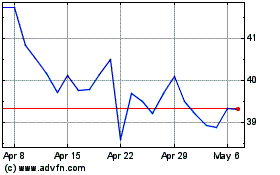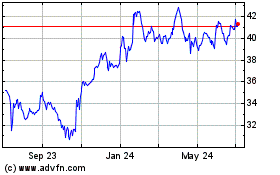By Sarah Krouse
Verizon Communications Inc.'s Oath unit is turning away from the
advertising- and data-centric strategy that spurred its
creation.
After failing to meet revenue targets by selling digital ads
across Yahoo and AOL properties, Oath executives now are focused on
selling content subscriptions and giving users ways to make
purchases through its sites, according to people familiar with the
matter.
The unit is exploring subscriptions to HuffPost news and Yahoo
Sports content, among other ideas, some of the people said. Earlier
this month, Oath said Yahoo Finance would start such a service in
early 2019. Oath's future ultimately will be determined by
Verizon's new chief executive, Hans Vestberg, a network expert who
took over the top job in August.
Oath was formed after Verizon spent about $9 billion to acquire
AOL and Yahoo, two struggling web pioneers. It was initially
pitched as an advertising rival to technology giants Facebook Inc.
and Alphabet Inc.'s Google. The deals, executives said at the time,
allowed Verizon to marry news and media sites like Flickr, Yahoo
Mail and TechCrunch with digital advertising technology and the
telecom company's data on wireless subscriber behavior.
Tim Armstrong, the former AOL boss who took the helm at Oath,
aimed to bolster page views across Oath's sites to two billion by
2020 from one billion in 2017. The division, he said, would
generate $10 billion in annual revenue by 2020.
But instead of making inroads in digital ads, Oath's market
share has shrunk: The unit is expected to capture just 3.3% of
total U.S. digital ad revenue in 2018, down from 4.1% last year,
according to eMarketer. In the first nine months of 2018, Oath
revenues totaled $5.6 billion, and Verizon executives said in
October they expect the unit to fall short of the 2020 goal.
Integrating AOL and Yahoo's advertising technology platforms
took longer than anticipated and still isn't complete, some of the
people familiar with the matter said. Verizon was unwilling to
share some data on its wireless subscribers that would have helped
create more sophisticated ad targeting, The Wall Street Journal has
reported. An attempt to create a mobile video app to woo
millennials also floundered.
Talks earlier this year about whether to spin off the Oath
business were unsuccessful, and Verizon instead opted to integrate
some of the operations more closely with the rest of the
152,000-person company. Those developments were among the reasons
Mr. Armstrong left, turning over leadership of Oath to K. Guru
Gowrappan, a 38-year-old former Yahoo and Alibaba Group
executive.
Behind Oath's latest shift is a recognition that some AOL and
Yahoo brands weren't well positioned for the latest changes in
media and advertising. Desktop ad revenue, which those sites long
depended on, is drying up as users increasingly prefer to access
content on their mobile devices. Mobile ads are less lucrative,
which meant the unit needed to find other ways to make money.
Executives decided that while Oath would still sell and serve
ads, they should focus more on getting existing users of properties
like Yahoo Finance and Yahoo Sports to visit more frequently, stay
longer and pay for some content, some of the people said.
"Everything we are doing is mobile first," Mr. Gowrappan told
employees at a November event in Cupertino, Calif., according to a
video viewed by the Journal. Mr. Gowrappan told employees that Oath
is home to brands that "laid the foundation for the internet,"
adding that some were "extraordinary and some forgettable."
Executives set out to identify Oath's strongest brands through a
continuing effort referred to internally as "Project Purple," which
some employees see as a nod to Yahoo and a sign that its brands
would be at the center of subscription products. The project could
result in Oath merging or eliminating some existing brands, some of
the people said.
Verizon may have to take a further financial write down on the
value of some assets within Oath, some of the people said.
In recent months, Oath has tried to plant Yahoo content more
effectively on devices used by Verizon's wireless, Fios and,
eventually, 5G customers. For example, Verizon formed a partnership
with Samsung Electronics Co. to preload some Yahoo apps on new
phones globally.
Mr. Armstrong, before he left, had been pitching a broader
membership concept. His plan included a chip card linked to Verizon
subscribers' phone numbers, which would make it easier to make
purchases, an idea the company is still considering.
Verizon's new CEO, Mr. Vestberg, has charged Oath executives
with identifying how news, sports and augmented and virtual reality
content would benefit from the faster 5G wireless network the
company is starting to build.
The carrier has reshuffled some top executives within Oath after
several senior departures. Bryn Mooser, co-founder of the augmented
and virtual reality studio Ryot, for example, is departing.
A spokeswoman for Verizon said Mr. Mooser is leaving to pursue
new opportunities. Mr. Mooser declined to comment.
Earlier this month, Mr. Vestberg said he would reorganize the
carrier and put Oath under a new business called Verizon Media
Group. Verizon is now pulling some Oath functions closer. For
instance, a team of Oath data scientists in the Midwest has been
asked to work on initiatives for Verizon's core wireless business,
some of the people said.
Those changes have spurred questions from employees and Wall
Street analysts about Verizon's long-term vision for Oath.
Mr. Vestberg has in recent months spent more time in Oath's
offices and studios. He addressed employees at the recent event in
Cupertino, where Oath employees presented their highest-priority
projects.
Wearing white sneakers that said "OBR," for "outside Basking
Ridge" (home of Verizon's main New Jersey offices), Mr. Vestberg
told employees he uses all of the unit's major apps for sports,
news and entertainment content.
He stressed the unit's importance to Verizon's corporate
strategy and said the business is moving beyond trying to integrate
Yahoo and AOL assets.
"I now declare that we are out of integration. We are now
delivering," Mr. Vestberg said to cheers from the crowd.
Write to Sarah Krouse at sarah.krouse@wsj.com
(END) Dow Jones Newswires
December 02, 2018 07:14 ET (12:14 GMT)
Copyright (c) 2018 Dow Jones & Company, Inc.
Verizon Communications (NYSE:VZ)
Historical Stock Chart
From Aug 2024 to Sep 2024

Verizon Communications (NYSE:VZ)
Historical Stock Chart
From Sep 2023 to Sep 2024
